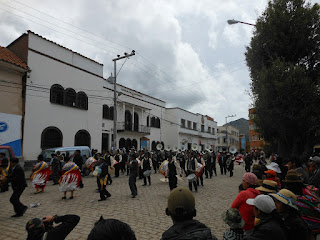31 January - 4 February
On the morning of the 31 January, the tour group of 15 people left La Paz for a town called Copacabana (Bolivian, not Brazilian!) on the shores of Lake Titicaca. The lake is the highest navigable lake at some 3,800 m above sea level, and straddles the border between Peru and Bolivia.
We reached a narrow strait over which the bus was ferried on a very rickety-looking barge:
Several hours later we arrived in Copacabana, late in the evening. The next day we toured to Isla del Sol (Island of the Sun), which was (and still is) considered a very important religious place for the local Aymaran people. They still meet here every winter solstice (June 21st) to celebrate the start of their new year. It was a beautifully stunning day with some equally stunning views:
The local Carneval was in full swing when we got back to the island, with brass bands filling the air with sound and the locals drinking copious amounts of beer. The traditionally-dressed Aymaran women were handling their liquor much better than the sleepy-looking men!
They all had a habit of pouring their beer into plastic cups, of which about half would be froth (partly due to altitude, partly due to drunkenness!) and then flicking the cup sideways to get rid of the froth - onto a passing gringo if one wasn't paying attention!
The next morning we had an early start scheduled to head across the border to Peru. However the lead guide of our two British guides decided to quit his job that morning, effective immediately... And the other guide had not been along this leg of the tour before! There was a lot of phone calls back and forward to the UK, and some (understandably!) very grumpy tourists, and it was the only bad experience I have really had so far this trip.
However, we eventually got away early afternoon, and it gave us a chance to see the parades through the streets that morning:
The local people have lived on these floating islands for hundreds of years. Some are now accepting of tourists, but many others remain separated from the world of technology and live solely off the fish they catch in the lake and the crops they can trade for on land.
Several thousand people live on these islands that are made of the reeds from the lake. The sensation of walking on the spongy reed floor is rather strange! The houses are all made of reeds also, although a small amount of power is now used on some of the islands (spot the solar panel in the photo above!).
The next day involved a rather long drive to the city of Cusco, Peru:
Cusco was the capital of the mighty Inca empire for many years, and sits about 3,500 m above sea level. The remains of Inca stonework is still visible around many places throughout and nearby the town, and although the Spaniards damaged, pillaged and destroyed much of the original work, some forms the foundations of many of the existing buildings.
During my first full day there, I managed to visit the main Catedral:
As well as Qoricancha (the Temple of the Sun):
The remainder of the day was spent packing for the Quechua Community trek to start the next day. The trek, and Machu Picchu, will have to wait for another post!









No comments:
Post a Comment